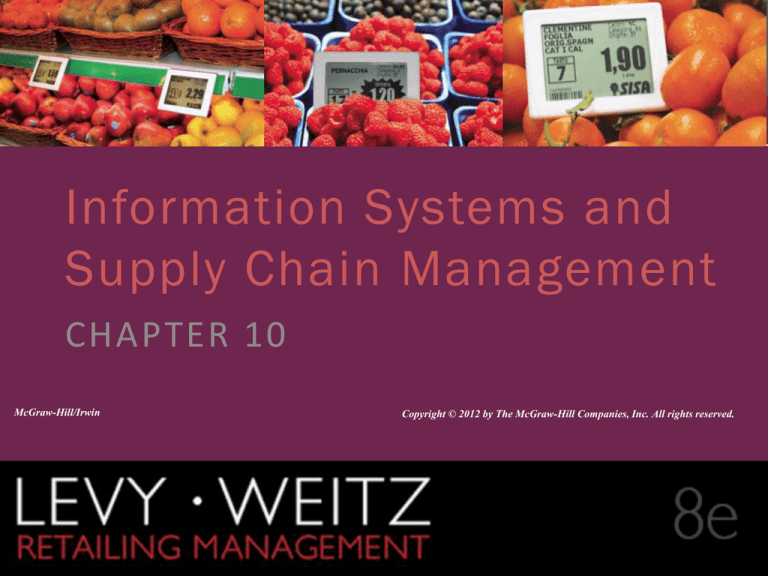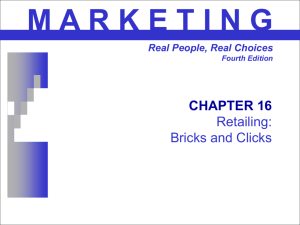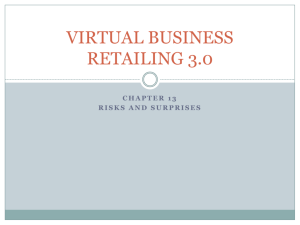
CCHHAAPPTTEERR 11
20
Information Systems and
Supply Chain Management
CHAPTER 10
McGraw-Hill/Irwin
Retailing Management 8e
Copyright © 2012 by The McGraw-Hill Companies, Inc. All rights reserved.
© The McGraw-Hill Companies, All rights reserved.
10 - 1
Retailing Strategy
CCHHAAPPTTEERR 11
20
Retail Market Strategy
Financial Strategy
Retail Locations
Retail Site Location
Human Resource Management
Information Systems and Supply Chain Management
Customer Relationship Management
10 - 2
Questions
CCHHAAPPTTEERR 11
20
• How does merchandise and information flow from the vendor to
the retailer to consumers?
• What activities are undertaken in a distribution center?
• What information technology (IT) developments are facilitating
vendor-retailer communications?
• How do retailers and vendors collaborate to make sure the right
merchandise is available when customers are ready to buy it?
• What are the benefits to vendors and retailers of collaboration on
supply chain management?
• What is RFID, and how will it affect retailing?
10 - 3
Supply chain management …..
CCHHAAPPTTEERR 11
20
• Efficient and effective integration of suppliers,
manufacturers, warehouses, stores, and transportation
intermediaries into a seamless value chain.
• Merchandise is produced and distributed in the right
quantities; to the right locations; and at the right time.
• Minimization of system wide
costs, while satisfying the
service levels their
customers require.
Ryan McVay/Getty Images
10 - 4
Illustration of Supply Chain
CCHHAAPPTTEERR 11
20
10 - 5
Why is Efficient Supply Chain Management so
Important to Retailers?
CCHHAAPPTTEERR 11
20
• Strategic advantage
• Improved product
availability
• Higher return on
investment
10 - 6
Strategic Importance of
Supply Chain Management
CCHHAAPPTTEERR 11
20
• Opportunity to Increase Sales by Making the Right
Merchandise is in the Right Place at the Right Time
• Fewer Stock-outs
• Greater Assortment with Less Inventory
• Opportunity to Reduce Costs
• Transportation Costs
• Inventory Holding Costs
• Improved ROI
10 - 7
Strategic Advantage : ZARA
CCHHAAPPTTEERR 11
20
• Timely information from store
mangers with handheld devices
to the corporate office
• Shorter cycle time from design to
production to delivery to stores
• Shorter lead time – own
production, small quantity
production in close proximity,
efficient logistics, premium
transportation, frequent delivery
• No discounts necessary
10 - 8
Strategic Advantage : Wal-Mart
CCHHAAPPTTEERR 11
20
• Wal-Mart’s success is from its information and supply
chain management systems
• Why are competitor’s lagging behind?
• Made a substantial investment in developing its
systems and has the scale economies
• Through experience and learning, changes are always
made to improve the system
• Coordinated effort of employees and functional areas
throughout the company
10 - 9
Improved Product Availability
• Benefits of Efficient
Supply Chain
Management to
Customers:
CCHHAAPPTTEERR 11
20
These benefits translate into
greater sales, lower costs, higher
inventory turnover, and lower
markdowns for retailers
• Reduced stockouts –
merchandise will be
available when the
customer wants them
• Tailoring assortments – the
right merchandise is
available at the right store
Ryan McVay/Getty Images
10 - 10
Higher Return on Investment
CCHHAAPPTTEERR 11
20
Return on assets = Net profit margin x Asset turnover
Net profit =
Total assets
Net profit x Net sales
Net sales
Total assets
Efficient Supply Chain Management leads to
• Increased Sales from more attractive assortments in stock
• Improved Net Profit Margins from increased gross margin and lowered
expenses
• Lowered inventory from less backup inventory in stock and higher asset
(inventory) turnover
Same Sales Using Less Inventory
10 - 11
Information and Merchandise Flows
CCHHAAPPTTEERR 11
20
10 - 12
Information Flows
CCHHAAPPTTEERR 11
20
10 - 13
Information Flows
CCHHAAPPTTEERR 11
20
When a customer purchases a toaster oven, sales
associate scans UPC code on merchandise and
customer credit card/loyalty card (Flow 1)
Steve Cole/Getty Images
Information about purchase is transmitted from
POS terminal to the buyer/planner. The
planner uses this information to monitor
and analyze sales and decide to reorder
more toaster ovens or reduce its prices if
sales are below expectations (Flow 2)
10 - 14
Information Flows
CCHHAAPPTTEERR 11
20
Sales transaction data are sent directly from the store to the vendor, and the
vendor decides when to ship more toaster ovens to the distribution center and
stores (Flow 3)
When inventory drops to a specified level in the
distribution center, buyer/planner communicates with
vendor, and then places a purchase order to re-supply
stores with toaster ovens (Flow 4)
StockTrek/Getty Images
10 - 15
Information Flows
CCHHAAPPTTEERR 11
20
Buyer/planner notifies distribution center about
incoming orders and how they are to be distributed
to stores (Flow 5)
PhotoLink/Getty Images
Store managers inform distribution center
about receipt of toaster ovens and coordinate
deliveries (Flow 6)
When the manufacturer ships the toaster ovens to the
distribution center, it sends an advanced shipping notice to
the distribution center (Flow 7)
David Buffington/Getty Images
10 - 16
Data Warehousing
CCHHAAPPTTEERR 11
20
• Data warehousing is the coordinated and periodic
copying of data from various sources, both inside and
outside the enterprise, into an environment ready for
analytical and informational processing
• Wal-Mart makes good use of its data warehouse.
Experts estimate that it is second in size only to that of
the U.S. government
10 - 17
Data Warehousing
CCHHAAPPTTEERR 11
20
10 - 18
Electronic Data Interchange
CCHHAAPPTTEERR 11
20
• EDI is the computer-to-computer exchange of business
documents between retailers and vendors
• Merchandise sales, Inventory On Hand, Orders
• Advanced shipping notices,
• Receipt of merchandise, Invoices for payment
10 - 19
Electronic Data Interchange
CCHHAAPPTTEERR 11
20
• EDI is the computer-to-computer exchange of business
documents between retailers and vendors
• Standards:
• UCS (Uniform Communication Standard)
• VICS (Voluntary Interindustry Commerce Solutions)
• Transmission system:
• Intranet: local area network (LAN) that employs Internet technology
• Extranet: collaborative network that uses Internet technology to link
businesses with suppliers, customers, etc.
10 - 20
EDI Security
CCHHAAPPTTEERR 11
20
• There are implications of security failures (loss of data,
loss of public confidence), but retailers have security
policy objectives:
Authentication – system assures person on
other end of session is who it claims to be
Authorization - that person has permission
to carry out request
Integrity – info arriving is the same that
was sent
Ryan McVay/Getty Images
10 - 21
The Physical
Flow of Merchandise - Logistics
CCHHAAPPTTEERR 11
20
• Logistics:
• The aspect of supply chain that refers to the planning,
implementation, and control of the efficient flow and
storage of goods, services, and related information
from the point of origin to the point of consumption
to meet customers’ requirements
10 - 22
Merchandise Flow
CCHHAAPPTTEERR 11
20
Retailers can have
merchandise shipped directly
to their stores (path 3) or to
their distribution centers
(paths 1 and 2)
10 - 23
Activities Performed
by Distribution Center
CCHHAAPPTTEERR 11
20
• Managing inbound transportation
• Receiving and checking
merchandise
• Storing or cross docking
merchandise
• Getting merchandise floor ready
• Ticketing and marking
• Putting on hangers
• Preparing to ship merchandise to a
store
• Managing outbound transportation
10 - 24
Advantages of Using
a Distribution Center
CCHHAAPPTTEERR 11
20
• More accurate sales forecasts are
possible when retailers combine
forecasts for many stores
serviced by one distributor
• Enables retailers to carry less
merchandise in the store
• Easier to avoid running out of
stock
• Retail store space is more
expensive than space at the
distribution center
10 - 25
Outsourcing Logistics
CCHHAAPPTTEERR 11
20
• Retailers consider outsourcing logistical functions if
those functions can be performed better or less
expensively by third-party logistics companies
• Transportation
• Warehousing
• Freight Forwarders
• Integrated Third-Party Logistics Services
10 - 26
Pull and Push Supply Chain
Push Supply Chain
Merchandise is allocated
to stores
on the basis of
forecasted demand
Less costly than a pull supply chain
Less sophisticated information needed system
to support it
Efficient for merchandise that has steady,
predictable demand
CCHHAAPPTTEERR 11
20
Pull Supply Chain
Orders for merchandise are
generated at the store level
on the basis of
POS sales data
Less likely to be overstocked or out of sock
Increases inventory turnover
Responsive to changes in customer demand
Efficient when demand is uncertain, and hard
to forecast
10 - 27
Advantages of Direct Store Delivery
CCHHAAPPTTEERR 11
20
• Gets merchandise faster, and is thus used for perishable
goods (meat and produce)
• Helps the retailer’s image of being the first to sell the
latest product (video games) or fads
• Some vendors provide direct store delivery for retailers
to ensure that their products are on the store’s shelves,
properly displayed, and fresh
10 - 28
Reverse Logistics
CCHHAAPPTTEERR 11
20
• The process of moving returned goods from their
customer destination for the purpose of capturing value
or proper disposal
• Retailers recover loss through on-line auctions
• Reverse-logistics systems are challenging
• Items may be damaged or require special handling
• Transportation costs are high
10 - 29
Supply Chain for
Fulfilling Catalog and Internet orders
CCHHAAPPTTEERR 11
20
• When fulfilling orders from individual consumers,
retailers ship small packages with one or two items to a
large number of different places
• Distribution centers for picking and packing orders for
consumers
10 - 30
Drop Shipping
CCHHAAPPTTEERR 11
20
• Drop-shipping, or consumer direct fulfillment, is a
system in which retailers receive orders from customers
and relay these orders to vendors and then the vendors
ship the merchandise ordered directly to the customer.
• Drop-shipping has been used for years by companies
that sell bulky products such as lumber, iron, and
petroleum, as well as catalog and mail-order companies.
10 - 31
Collaboration between Retailers and Vendors
in Supply Chain Management
CCHHAAPPTTEERR 11
20
• Bullwhip Effect - The built up inventory in an
uncoordinated channel where retailers and vendors do
not coordinate their supply chain activities
10 - 32
What Causes a Bullwhip Effect?
CCHHAAPPTTEERR 11
20
• Delays in transmitting orders and receiving merchandise
• Over-reacting to shortages
• Ordering in batches rather than generating a number of
small orders
10 - 33
Collaboration between Retailers and Vendors
in Supply Chain Management
CCHHAAPPTTEERR 11
20
Four approaches for coordinating supply chain
activities to reduce the level of inventory in the
chain and reduce the number of stock-outs
(in order of the level of collaboration)
PhotoDisc/Getty Images
• Use EDI
• Share information to reduce need for backup inventory, improve sales
forecasts and production efficiency
• Vendor manage inventory (VMI)
• Collaborative planning, forecasting and replacement (CPFR)
10 - 34
Initial Efforts at Coordinating
Vendor and Retailer Supply Chain
Efficient Consumer Response
(ECR) – Food Retailing
• Trade Promotions => Forward Buying
=> Extremely Uneven Production
• Motivation for Packaged Goods Mfrg
• Stop Price Promotion, Forward Buying
• Level Out Demand
• Motivation for Supermarkets
• Rise of Warehouse Clubs/Discount
Store
CCHHAAPPTTEERR 11
20
Quick Response (QR) Apparel
• Inherently Unpredictable Demand
• Old Solution - Over Buying and
Markdown
• Quick Response (modeled after JIT)
•
•
•
•
Provide Initial Assortment
Forecast Sales for Intermediate Form
Monitor Early Sales
Make Final Assortment
• Use of EDLP Pricing
• Need to Become More Efficient
• Excessive Inventory - $30 Billion
10 - 35
Vendor Managed Inventory (VMI)
CCHHAAPPTTEERR 11
20
• Manufacturer access to POS information
• Replenishment automatically triggered
• Enables demand-based view of replenishment &
production planning – reduce bull whip effect
10 - 36
CPFR (Collaborative Planning,
Forecasting, and Replenishiment)
CCHHAAPPTTEERR 11
20
• Developed by VICS and adopted by ECR Europe
• The sharing of forecast and related business information
and collaborative planning between retailers and
vendors to improve supply chain efficiency and product
replenishment
• The most advanced form of retailer-vendor
collaboration that involves sharing proprietary
information, such as business strategies, promotion
plans, new product developments and introductions,
production schedules, and lead time information.
10 - 37
CPFR (Collaborative Planning,
Forecasting, and Replenishiment)
CCHHAAPPTTEERR 11
20
• Common goals
• A single demand forecast developed collaboratively
• Collaborative Promotional planning & execution
• A single, shared data source
• Improved inventory management across Supply Chain
• Optimized replenishment strategies with joint
ownership
• Process simplicity creates optimal framework for
success
10 - 38
Radio Frequency Identification (RFID)
CCHHAAPPTTEERR 11
20
• Radio Frequency Identification (RFID) allows
an object or a person to be identified at a
distance using radio waves.
• Reduces warehouse and distribution labor
costs
• Reduces point of sale labor costs
• Inventory savings by reducing inventory errors
• Reduces theft – products can be tracked
• Reduces out of stock conditions
10 - 39
Impediments to the Adoption of RFID
CCHHAAPPTTEERR 11
20
• RFID is expensive – the return on
investment is low
• It still only makes sense to put
tags on pallets, cartons,
expensive merchandise or high
theft items
• RFID generates more data than
what can be currently processed
• Consumers worry about privacy
invasion
10 - 40







